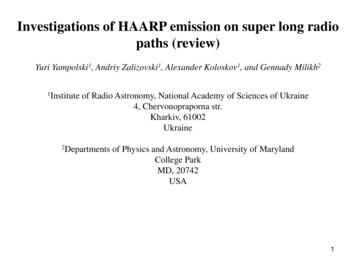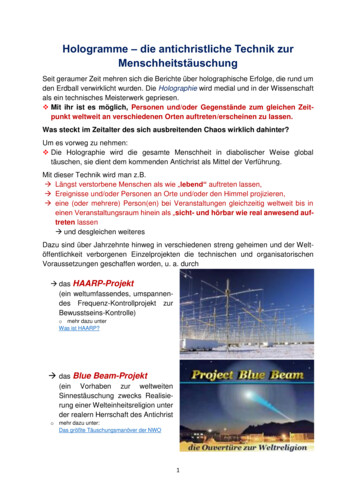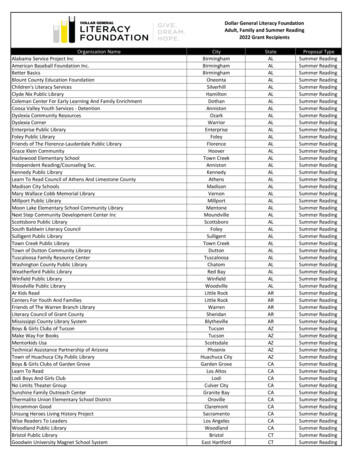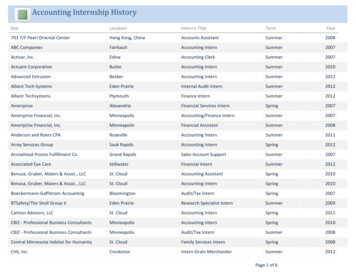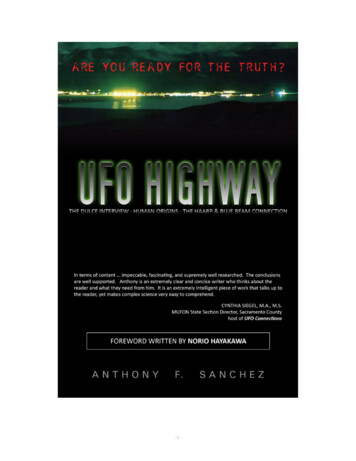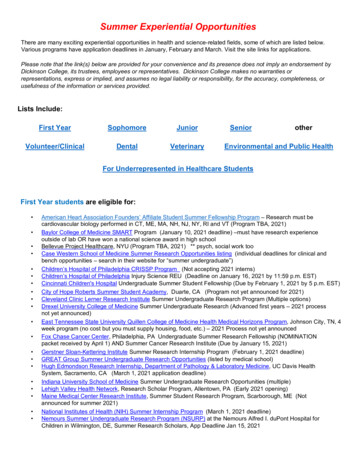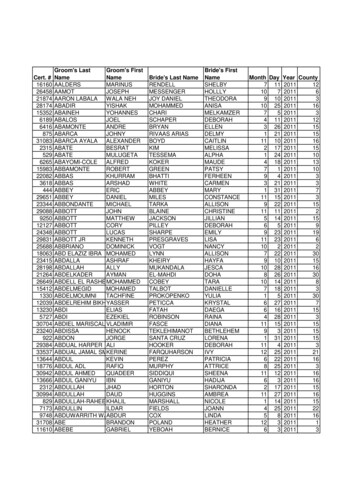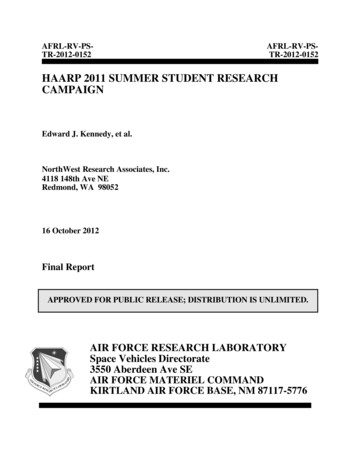
Transcription
AFRL-RV-PSTR-2012-0152AFRL-RV-PSTR-2012-0152HAARP 2011 SUMMER STUDENT RESEARCHCAMPAIGNEdward J. Kennedy, et al.NorthWest Research Associates, Inc.4118 148th Ave NERedmond, WA 9805216 October 2012Final ReportAPPROVED FOR PUBLIC RELEASE; DISTRIBUTION IS UNLIMITED.AIR FORCE RESEARCH LABORATORYSpace Vehicles Directorate3550 Aberdeen Ave SEAIR FORCE MATERIEL COMMANDKIRTLAND AIR FORCE BASE, NM 87117-5776
DTIC COPYNOTICE AND SIGNATURE PAGEUsing Government drawings, specifications, or other data included in this document forany purpose other than Government procurement does not in any way obligate the U.S.Government. The fact that the Government formulated or supplied the drawings,specifications, or other data does not license the holder or any other person or corporation;or convey any rights or permission to manufacture, use, or sell any patented invention thatmay relate to them.This report was cleared for public release by the 377 ABW Public Affairs Office and isavailable to the general public, including foreign nationals. Copies may be obtained from theDefense Technical Information Center (DTIC) (http://www.dtic.mil).AFRL-RV-PS-TR-2012-0152 HAS BEEN REVIEWED AND IS APPROVED FORPUBLICATION IN ACCORDANCE WITH ASSIGNED DISTRIBUTION STATEMENT.//signed//Craig A. SelcherProject Manager, AFRL/RVBXI//signed//Edward J. Masterson, Colonel, USAFChief, AFRL/RVBThis report is published in the interest of scientific and technical information exchange, and itspublication does not constitute the Government’s approval or disapproval of its ideas or findings.Approved for public release; distribution is unlimited.
Form ApprovedOMB No. 0704-0188REPORT DOCUMENTATION PAGEPublic reporting burden for this collection of information is estimated to average 1 hour per response, including the time for reviewing instructions, searching existing data sources, gathering andmaintaining the data needed, and completing and reviewing this collection of information. Send comments regarding this burden estimate or any other aspect of this collection of information,including suggestions for reducing this burden to Department of Defense, Washington Headquarters Services, Directorate for Information Operations and Reports (0704-0188), 1215 Jefferson DavisHighway, Suite 1204, Arlington, VA 22202-4302. Respondents should be aware that notwithstanding any other provision of law, no person shall be subject to any penalty for failing to comply with acollection of information if it does not display a currently valid OMB control number. PLEASE DO NOT RETURN YOUR FORM TO THE ABOVE ADDRESS.1. REPORT DATE (DD-MM-YYYY)16-10-20122. REPORT TYPE3. DATES COVERED (From - To)Final Report18 Jul 2008 – 25 Jul 20124. TITLE AND SUBTITLE5a. CONTRACT NUMBERFA8718-08-C-00495b. GRANT NUMBERHAARP 2011 SUMMER STUDENT RESEARCH CAMPAIGN5c. PROGRAM ELEMENT NUMBER62601F6. AUTHOR(S)5d. PROJECT NUMBERE. J. Kennedy, J. A. Secan, and A. L. Snyder5e. TASK NUMBER1010PPM000040805f. WORK UNIT NUMBEREF0040327. PERFORMING ORGANIZATION NAME(S) AND ADDRESS(ES)8. PERFORMING ORGANIZATIONREPORT NUMBERNorthWest Research Associates, Inc.4118 148th Ave NERedmond, WA 98052NWRA-12-RS47810. SPONSOR/MONITOR’S ACRONYM(S)9. SPONSORING / MONITORING AGENCY NAME(S) AND ADDRESS(ES)Air Force Research LaboratorySpace Vehicles Directorate3550 Aberdeen Avenue SEKirtland AFB, NM 87117-5776AFRL/RVBXI11. SPONSOR/MONITOR’S REPORTNUMBER(S)AFRL-RV-PS-TR-2012-015212. DISTRIBUTION / AVAILABILITY STATEMENTApproved for public release; distribution is unlimited. (377ABW-2011-1475 dtd 14 Oct 2011)13. SUPPLEMENTARY NOTES14. ABSTRACTThe 2011 Summer Student Research Campaign (SSRC) was conducted at the High Frequency Active Auroral Research Program(HAARP) Research Station in Gakona, Alaska during the period 18–27 July 2011. The SSRC included 26 students and mentorsrepresenting 11 universities and federal research laboratories. The program included daily meetings to provide a forum forreporting results and discussion of individual experiments and included a daily scientific presentation or tutorial. Scientific topicsaddressed experimentally included studies of Stimulated Electromagnetic Emission, F-region Artificial Field-AlignedIrregularities, effects of scintillation on GPS signals, studies of the Extremely Low Frequency (ELF) generation region and ofmethods for improving conversion efficiency, and the incorporation of sophisticated modulation techniques to improve the qualityof ionospherically generated ELF communication signals using QPSK and error correction.15. SUBJECT TERMSIonosphere, Ionospheric modification, Ionospheric irregularities, Ionospheric optical emissions, Ionospheric scintillation, HAARP,Simulated Electromagnetic Emissions16. SECURITY CLASSIFICATION OF:a. REPORTUnclassifiedb. ABSTRACTUnclassified17. LIMITATIONOF ABSTRACTc. THIS PAGEUnclassifiedUnlimited18.NUMBEROFPAGES4419a. NAME OF RESPONSIBLE PERSONCraig Selcher19b. TELEPHONE NUMBER (include areacode)Standard Form 298 (Rev. 8-98)Prescribed by ANSI Std. Z39.18i
This page is intentionally left blank.iiApproved for public release; distribution is unlimited.
ContentsPreface and Acknowledgements. . v1.Background: The 2011 HAARP Summer Student Research Campaign. . 12.Overview of the HAARP Summer Student Research Campaign . 22.1Considerations for the Schedule Development . 32.2Final SSRC Experiment Schedule . 72.3Daily Group Meetings . 163.Student Experiments Summaries . 174.Summary and Concluding Remarks . 19Bibliography. 21Appendix: Geophysical Conditions During the Campaign Interval . 22List of Symbols, Abbreviations, and Acronyms . 33iiiApproved for public release; distribution is unlimited.
FiguresFigure 1.Prediction of F-region critical frequency (foF2) as a function of timeof day (in Alaska Daylight Time) for July 2011. Yellow horizontalbands indicate frequency allocations in effect during SSRC11. . 4Figure 2.Planetary Kp recurrence diagram for six solar rotations prior tothe SSRC 2011 experimentation period (shown in yellow) . 5Figure 3.Conceptual operation schedule for the SSRC 2011. The blueshaded area shows the time allocated for experiments oneach of the experimental days at the HAARP Research Station. 8Figure 4.Division of total available campaign time by PrincipalInvestigator for the 2011 HAARP SSRC. 14Figure 5.Division of total available campaign time by Universityparticipating in the 2011 HAARP SSRC . 15Figure 6.Some of the participants in the HAARP 2011 SSRC standing infront of the HF transmitter and antenna array . 15TablesTable 1.Frequency Allocations for the HAARP Research Station inEffect During the 2011 SSRC . 3Table 2.HAARP 2011 SSRC Research Schedule as Executed . 9Table 3.HAARP 2011 SSRC Daily Meeting and Lecture Schedule . 16ivApproved for public release; distribution is unlimited.
Preface and AcknowledgementsThe HAARP 2011 Summer Student Research Campaign was conducted at the HAARPGakona Facility over the period 18 - 27 August 2011. The campaign was scheduled as anopportunity for university graduate students to visit the HAARP facility and becomefamiliar with using it for research purposes by planning, executing and reporting onexperiments of their own design. The format of the activity required that each student beassisted by a mentor. Nine operational days were included in order to take advantage of awide variety of background ionospheric conditions and to provide ample time for eachstudent to investigate variations within their experiment plan. The campaign period alsoincluded daily meetings at which tutorials or presentations were provided by a mentor orother visiting scientist. Students were encouraged to provide interim results of theirexperiments during these daily meetings.We would like to acknowledge the participation of each of the mentors and other visitingscientists who provided tutorials and daily consultative guidance to the students. We alsowant to acknowledge the HAARP facility’s staff and the transmitter system operators. Theoften complex and sophisticated transmitter and antenna beam operations and frequentexperiment revisions required expertise and dedicated effort that was greatly appreciatedby all participants. We particularly recognize the efforts of the following individuals whoset up each of the experiments and operated the transmitter and antenna array during thecampaign.Dr. Mike McCarrickChief Scientist and operatorDr. Helio ZwiSoftware engineer and operatorDavid Seafolk-KoppSoftware engineer and operatorBen UscinskiSoftware engineer and operatorWe also gratefully acknowledge the significant time and effort invested by Dr. BrentonWatkins of the Geophysical Institute who operated the HAARP Modular UHF IonosphericRadar during the campaign.Less visible but equally as important to the campaign’s success were the contributions bythe site support staff who provided support services, transmitter and diagnosticmaintenance and assisted individual researchers in equipment set up data retrieval. The100% availability of the transmitter system during this campaign was a direct result of thework invested by the following staff members and we are grateful for their contributions:Marty KarjalaDeana RietveldJay ScrimshawTravis MillionTracy CoonDave CoonStef ScribnerJosh GeldersmaHAARP Site ManagerHAARP Admin AssistantHAARP Senior Electrical EngineerHAARP Power EngineerHAARP Associate Electrical EngineerHAARP Associate Electrical EngineerHAARP Maintenance TechnicianHAARP Maintenance TechnicianvApproved for public release; distribution is unlimited.
This page is intentionally left blank.viApproved for public release; distribution is unlimited.
1.Background: The 2011 HAARP Summer Student Research CampaignFrom 2000 until 2008, the High Frequency Active Research Program (HAARP) and theNational Science Foundation (NSF) sponsored an annual learning and research program inAlaska for graduate level students lasting ten days to two weeks. The goal of this program,called the Polar Aeronomy and Radio Science (PARS) Summer School, was to acquaintuniversity students with many of the scientific facilities located in Alaska and to providean introduction to conducting research at the HAARP Research Station in Gakona, Alaska.The Summer School was planned and conducted jointly by HAARP and by the Universityof Alaska Fairbanks (UAF) and was split into two segments. The first portion of the schoolwas held at UAF and included a series of targeted lectures along with visitations toscientific facilities in the Fairbanks area including the UAF Poker Flat Research Range(PFRR). The Summer School then moved to Gakona, Alaska for a short, four-day researchcampaign at the HAARP Research Station. While at HAARP, students would consult withtheir mentors or with other visiting scientists to plan and execute experiments of their owndesign while cooperating with the facility operators to learn the high power transmitter’scapabilities and limitations and learning to use the facility’s suite of diagnostic andscientific instruments. The duration of the research portion of the PARS Summer Schoolwas long enough to permit short experimentation periods for each student participating inthe program.Beginning in 2009, the timing for the traditional PARS Summer School was changed to abiennial schedule to relieve the workload for UAF personnel who planned or participatedin the activity. In the intervening years, a new program called the Summer StudentResearch Campaign (SSRC) was conducted to retain the opportunity for students toparticipate in a research campaign at HAARP albeit without the concentrated lectureperiod at UAF. The main focus of the SSRC is to expose university students to thecapabilities of the HAARP facility by having them develop, conduct and report onindividual research experiments while acting as a Principal Investigator (PI) in a campaigntype atmosphere. Increasingly, students at many universities have returned several times toHAARP during the yearly PARS or SSRC activity to continue and expand on researchbegun during their first year, usually as part of their doctoral program.The SSRC expands on the PARS Summer School by providing a significant increase infacility operational time. This has advantages in several areas including permitting thedesign of more exhaustive investigations and reducing the impact of one day’s unfavorablebackground geomagnetic conditions by making available multiple opportunities to conductexperiments.The increased time at HAARP has also engendered the development of group participationin experiment development in the way experiments were conducted at the earlyionospheric interaction facilities at Arecibo and EISCAT. Each day, at the daily meeting,students are asked to present a briefing on their experiment including its goals, proceduresand expected results. The group (students and mentors) is encouraged to ask questions andcomment on the approach taken. Students are also given the chance to present interimresults at these daily meetings and the group is again encouraged to offer suggestions onimproving the experiment. More will be said about the daily activities in a later section.1Approved for public release; distribution is unlimited.
The second biennial SSRC was planned and organized for the HAARP program byNorthWest Research Associates (NWRA) and was conducted at the HAARP ResearchStation during the period 18 – 27 July 2011. A goal of 80 hours was set for total campaigntime which would allow in excess of 3 hours per participant over the 8 day period.2.Overview of the HAARP Summer Student Research CampaignThe decision to proceed with planning for the 2011 SSRC was made during a mid-Mayteleconference with personnel form AFRL, NRL and NWRA and a preliminary timetablewas established. An announcement soliciting interest would be sent immediately toprevious SSRC and PARS participants and to professors at universities participating inHAARP research through grants and contracts with the expectation that the announcementwould be distributed further throughout the community. At the time of the teleconference,the availability of fuel to support the campaign was still an uncertainty, but a tentative goalof 80 hours of operational time was establishedThe announcement was distributed and although it was not a firm commitment to theactivity it did request potential experiment descriptions by 25 May 2011 and indicated thata decision to go ahead with the campaign would be made by 3 June along with notificationthat each responder’s experiment had been accepted or rejected. At this time, a specialSSRC 2011 web site was set up using the HAARP web server. The SSRC web site waspopulated with information on the preparation and submission of information required tovisit the HAARP facility, information on how to prepare a research proposal for HAARP,and additional supplementary information.At this time, the UAF was contacted to determine their availability and willingness toassist with certain administrative aspects of the program as they had during the SSRC 2009including arranging for and reimbursing some student expenses associated with travel tothe HAARP facility, subject to a fixed budgetary allotment.A total of 23 proposals were received in response to the announcement. The proposalswere reviewed by a committee consisting of the HAARP program managers and NWRAscientists. Because all of the proposals were sound and scientifically interesting andbecause the number received would permit over 3 hours of operational allocation to eachexperiment, all of the submissions were accepted. The proposers were notified ofacceptance by e-mail on 5 June 2011 and instructions were provided on how to proceedwith making travel arrangements through the UAF.The instructions for proposal preparation included a request that any special frequenciesneeded for the experiment be specified in the submission. The proposals were examinedcarefully to determine frequencies not within the HAARP Research Station permanentfrequency allocation. As in previous campaigns, several experiments were focused onexamining Stimulated Electromagnetic Emission (SEE) or F-region Artificial Field-alignedIrregularities (AFAI), both of which exhibit unusual or enhanced effects when theoperating frequency is close to a multiple of the electron gyrofrequency of approximately1.45 MHz. Although the 2nd gyroharmonic is covered by the existing HAARP permanentfrequency allocation, all higher harmonics are not. Therefore, the HAARP programmanager was asked to request a temporary authorization from the regional frequency2Approved for public release; distribution is unlimited.
management office at Elmendorf AFB, to include these special frequencies. Table 1 is alisting of the frequency allocations that were in effect during the 2011 SSRC.Table 1. Frequency Allocations for the HAARP Research Station in Effect Duringthe 2011 SSRC2650-2850 kHz *2850-3050 kHz3155-3400 kHz4040-4438 kHz4438-4650 kHz4750-4995 kHz5005-5450 kHz5450-5700 kHz5730-5950 kHz6765-7000 kHz7300-8100 kHz9040-9995 kHz **(Temporary)(Temporary)(Temporary)* Equipment limitations apply to frequencies below 2.7 MHz** Equipment limitations apply to frequencies above 9.6 MHz2.1Considerations for the Schedule DevelopmentDevelopment of the campaign schedule was based on several factors including requests forspecific times associated with satellite passes, requests for specific dates in order toaccommodate travel plans, or the availability of specific diagnostic instruments, orrequirements for specific ionospheric conditions. Each of these factors is discussed ingreater detail in the following sections.Satellite PassesThe development of a campaign experiment schedule always begins with penciling in allof the relevant satellite passes discussed in the proposals. In previous campaigns, studentinterest areas included experiments involving satellites in low earth orbit (LEO); however,for the SSRC 2011, there were no such requests and only Global Navigation SatelliteSystem (GNSS) satellites were mentioned. (GNSS satellites include United States GlobalPositioning System (GPS) and the Russian GLONASS satellites.) Unlike LEO satelliteswhose orbits are characterized by short duration overhead passes, GNSS satellites areabove the horizon for durations measured in hours and the times of interest forexperimental purposes are dependent on the satellite moving into certain regions of the sky(e.g., near magnetic zenith). Typically, this favorable signal path geometry only lasts for 20to 30 minutes. For SSRC 2011, GPS satellite receivers were set up on diagnostic pad 3 atthe HAARP facility and at a nearby location just off site. The GNSS proposal providedpredictions of the times when the required geometry would be satisfied. On any given daythere were a sufficient number of acceptable GNSS “passes” to allow some degree offlexibility in scheduling these experiments consecutively with other, non-satellitedependent experiments.3Approved for public release; distribution is unlimited.
Ionospheric ConditionsIn contrast to previous PARS and SSRC activities, the 2011 campaign took place duringthe rising phase of the solar sunspot cycle. Therefore, solar activity was expected to bemoderate (SSN 50) producing relatively high ionospheric densities. (The actualInternational Sunspot Number for July 2011 was 43.9 and the Smoothed Sunspot Numberwas 57.2.) When combined with the seasonal characteristics of the high latitudeionosphere, this resulted in several advantages for scheduling and conducting experiments:(1) Higher ionospheric density yields higher F-region critical frequency (foF2) which, inturn, allows greater use of the entire HAARP frequency allocation, (2) The availability ofhigher HAARP operating frequencies means that greater Effective Radiated Power (ERP)can be used in the experiments, (3) Greater ionization density combined with small solardepression angles after sunset (in the summer at high latitudes), means the criticalfrequency remains high late into the evening.The success of many of the experiments was dependent on specific ionospheric conditions.For a large number of the experiments, operation at a frequency at or just below the Fregion is essential. To assist in the schedule development, a prediction of F-region criticalfrequency foF2 was prepared using the ITS78 ionospheric model. The prediction was madefor two levels of sunspot number, SSN 50 and SSN 75. Figure 1 shows the results ofthis prediction. (For comparison, the observed variation of foF2 as a function of time foreach of the days during the SSRC campaign is given in Figures 16 and 17 in theAppendix).Figure 1. Prediction of F-region critical frequency (foF2) as a function of time of day (inAlaska Daylight Time) for July 2011. Yellow horizontal bands indicate frequencyallocations in effect during SSRC11.4Approved for public release; distribution is unlimited.
Several observations can be made from Figure 1. First, as a consequence of the higherpoint in the sunspot cycle and correspondingly greater ionospheric density along with longdaylight hours in Alaska during the summer, foF2 never drops below the lowest availableHAARP operating frequency, thus providing confidence in scheduling F-regionexperiments at any time of day, subject to specific experiment requirements.For example, some of the experiments depended on being able to operate the HAARPtransmitter at or just below foF2. For these experiments, it is not possible to continuouslytrack the falling critical frequency after about 01:00 Alaska Daylight Time (ADT) becausefoF2 enters a forbidden frequency band. In addition, Figure 1 shows that thoseexperiments requiring operation at the third gyroharmonic (approximately 4.2 MHz) maynot be possible between the hours of 00:00 – 07:00 ADT.One of the students participating in previous PARS/SSRC campaigns had beeninvestigating E-region Field Aligned Irregularities using the Cornell VHF Radar located inHomer, Alaska. The E-region reaches its maximum ionization around local noon and thishas added the scheduling complexity of providing mid-day and evening operations duringthe same campaign day. This student did not participate in SSRC 2011 with the result thatday/night scheduling conflicts were not an issue.Eleven of the proposers requested that their experiment be scheduled during times of theday when the auroral electrojet is most likely to be present in order to maximize thelikelihood of good ELF generation. The occurrence of an overhead auroral electrojet iscorrelated with disturbed ionospheric conditions driven by solar activity and quantified bythe planetary Kp index. A review of the Kp record for several solar cycles prior to theSummer School experimentation period (see Figure 2) showed recurrent disturbedconditions (high Kp) at a point in the solar rotation that would correspond with at least aportion of the campaign.Figure 2. Planetary Kp recurrence diagram for six solar rotations prior to the SSRC 2011experimentation period (shown in yellow).5Approved for public release; distribution is unlimited.
Recurring disturbances are usually typical of a persistent coronal hole and a review of thecoronal hole history for several solar rotations prior to the campaign period does reveal thispattern for a reappearing transequatorial coronal hole (designated CH446, CH450 andCH457 in the immediately preceding solar rotations). A review of conditions actuallyobserved during the campaign (for example, see Figure 7 in the Appendix) showsdisturbed conditions during the period 18-23 July due to coronal hole CH466 which is thereappearance of the same transequatorial coronal hole.Through many years of operations at HAARP, it has been observed that under moderategeomagnetic conditions, the most productive hours for ELF generation are those just priorto local magnetic midnight. During this time period, the auroral oval (and coincidentelectrojet) is north of, but moving toward HAARP as the earth rotates the magnetic poletoward the longitude of HAARP. Generally, absorption is low as the electrojet movessouthward over the HAARP facility (evidenced by low riometer absorption and anincreasing, positive H magnetic field component shown on the magnetometer). For higherKp, these events generally take place earlier in the evening. For very high Kp or at latertimes, the auroral oval may move to the south of HAARP (as evidenced by a negativemagnetic field H component indicating a westward electrojet current) and there is a greaterlikelihood of increased absorption due to auroral precipitation, with the result that ELFsignal generation may decrease. Therefore, ELF generation experiments requiring anelectrojet are generally scheduled for the hours just prior to the closest approach of theauroral oval (21:00 – 02:00 ADT). Because of the large number of requests for time whenthe auroral electrojet is most likely to occur, the 2011 SRC campaign schedule was set upto include these late evening hours. The daily campaign start time was driven byexperiments requiring foF2 to be above 4.2 MHz to permit investigation of SEE or AFAIeffects at the 3rd gyroharmonic. As discussed previously, conditions favoring a highenough critical frequency for these experiments had to be scheduled prior to 00:00 ADT.Based on the Kp recurrence chart, the bulk of ELF experiments were scheduled at thebeginning of the campaign. In reviewing results of the ELF experiments conducted duringthe campaign, this turned out to be a very good scheduling decision.Operator Endurance and Facility LimitationsThe scientists, engineers and technicians who operate the HAARP transmitter andsupporting infrastructure are dedicated personnel who, nevertheless, have endurancelimitations. Typically, the facility can be operated for periods of 10 to 12 hours before theoperators require a break. In addition, some equipment failures can be expected in normaloperation and the site personnel require transmitter down times measured in hours in orderto bring the facility back to full capability. The fuel budget established for this campaignlimited the total number of campaign hours to approximately 80 and spreading those hoursover the 9 campaign days resulted in daily operations well-within operator and facilityendurance limits.Special Schedule RequestsThe students and mentor from MIT and Boston University requested that their experiments(S01 through S05) be scheduled prior to 23 July in order to meet a previously scheduledcampaign assignment at the Arecibo Observatory in Puerto Rico. The schedule wasadjusted accordingly for these experiments. However, it was not possible to provide the6Approved for public release; distribution is unlimited.
full quota of hours to all of these experiments since they also required special geomagneticconditions.One experiment (S09) was run as a probe to determine if special and unique ionosphericconditions were present. The probe was generally scheduled at or near the beginning of thehour, lasting for one minute. If the desired conditions were present, the schedule would beinterrupted and the full special experiment would be run. Unfortunately, the desiredconditions were not observed at any time during the 2011 SSRC campaign.Availability of Diagnostic InstrumentsThe two main diagnostic instruments requested in the proposals were the HAARP ModularIonospheric Radar (MUIR) and the SuperDARN facility located on Kodiak Island, AK.The MUIR, which is located on-site at the HAARP facility, is operated by the UAF/GI forall research. The MUIR was requested for nearly all of the F-region experiments and formany of the ELF experiments. The UAF scientist who operates MUIR during campaignswas able to be present at the site from 18-25 July. Experiments requiring MUIR werescheduled to coincide with those dates.SuperDARN was requested by those experiments investigating F-region SEE or AFAI. Ingeneral, assignment of individual experiment (also termed “discretionary”) time fromSuperDARN requires submission of the request 90 days in advance. Because of the latedecision to conduct the 2011 SSRC, it was not possible to meet this SuperDARN lead timerequirement. However, a discretionary time block was in the SuperDARN schedulebeginning 22 July at 16:00 ADT through the end of the campaign. Prior to that date,SuperDARN managers were able to provide 1 minute scans on a per-request basis. Finally,the special “HAARP mode” (one beam position dedicated to HAARP but with time-gateand integration limitations tied to the primary user) was available for the whole campaignperiod.Students from MIT and Boston University brought a new instrument to this campaign tosupport their experiment and set it at the HAARP facility’s most distant diagnostic pad.This instrument, called the Geomagnetic Observatory System (GMOS) is capable ofmeasuring very small fluctuations in the geomagnetic field.Two other groups brought specialized instruments which were installed at locatio
The HAARP 2011 Summer Student Research Campaign was conducted at the HAARP Gakona Facility over the period 18 - 27 August 2011. The campaign was scheduled as an opportunity for university graduate students to visit the HAARP facility and become familiar with using it for research purposes by planning, executing and reporting on
